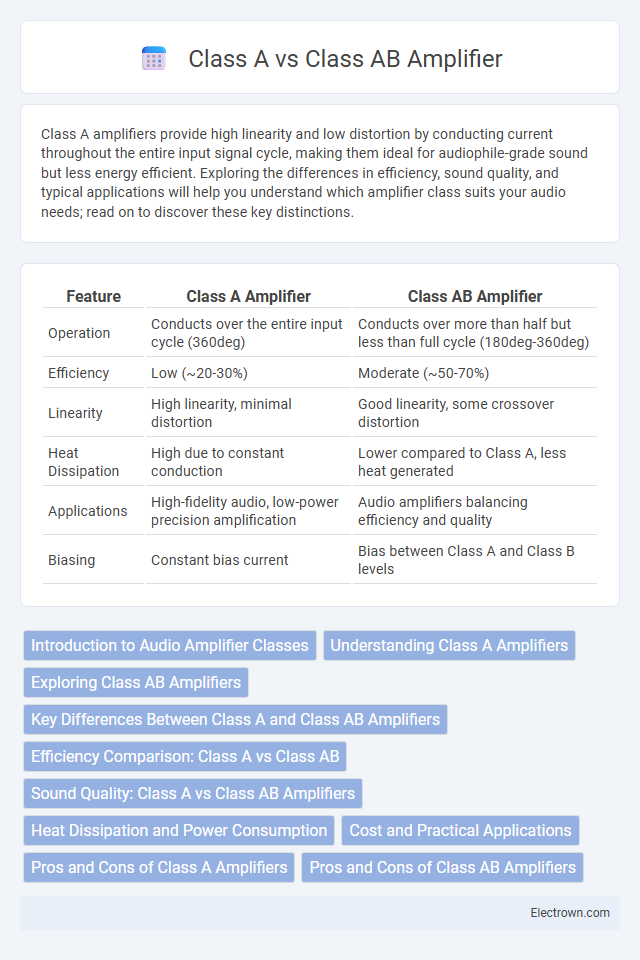Class A amplifiers provide high linearity and low distortion by conducting current throughout the entire input signal cycle, making them ideal for audiophile-grade sound but less energy efficient. Exploring the differences in efficiency, sound quality, and typical applications will help you understand which amplifier class suits your audio needs; read on to discover these key distinctions.
Table of Comparison
| Feature | Class A Amplifier | Class AB Amplifier |
|---|---|---|
| Operation | Conducts over the entire input cycle (360deg) | Conducts over more than half but less than full cycle (180deg-360deg) |
| Efficiency | Low (~20-30%) | Moderate (~50-70%) |
| Linearity | High linearity, minimal distortion | Good linearity, some crossover distortion |
| Heat Dissipation | High due to constant conduction | Lower compared to Class A, less heat generated |
| Applications | High-fidelity audio, low-power precision amplification | Audio amplifiers balancing efficiency and quality |
| Biasing | Constant bias current | Bias between Class A and Class B levels |
Introduction to Audio Amplifier Classes
Class A amplifiers operate with the output transistor conducting continuously, providing high linearity and low distortion ideal for audiophiles seeking pristine sound quality. Class AB amplifiers combine the benefits of Class A and Class B designs by allowing the output transistors to conduct for more than half the input signal cycle, improving efficiency while maintaining moderate distortion levels. These amplifier classes differ significantly in power efficiency, heat dissipation, and audio fidelity, impacting their application in high-performance audio systems.
Understanding Class A Amplifiers
Class A amplifiers operate with the output transistor conducting throughout the entire input signal cycle, resulting in high linearity and low distortion. They typically exhibit low efficiency, often around 20-30%, due to continuous current flow regardless of the signal amplitude. Class A designs are favored in high-fidelity audio applications where sound quality is prioritized over power efficiency.
Exploring Class AB Amplifiers
Class AB amplifiers combine the low distortion of Class A designs with the higher efficiency of Class B, making them ideal for audio applications requiring both quality and power savings. By operating transistors in a conduction angle between 180deg and 360deg, Class AB amplifiers reduce crossover distortion typical in Class B amplifiers while maintaining better thermal management than Class A. Your audio system can benefit from Class AB amplifiers' ability to deliver clean sound with improved efficiency for extended performance and reliability.
Key Differences Between Class A and Class AB Amplifiers
Class A amplifiers conduct current throughout the entire input signal cycle, resulting in high linearity and low distortion but lower efficiency, typically around 20-30%. Class AB amplifiers combine the conduction of Class A and Class B designs, allowing current flow for more than half but less than the entire cycle, improving efficiency up to 50-70% while maintaining relatively low distortion. The key difference lies in their conduction angle, where Class A amplifiers operate in a continuous mode, and Class AB amplifiers operate with a partial conduction angle to balance sound quality and power efficiency.
Efficiency Comparison: Class A vs Class AB
Class A amplifiers typically operate with an efficiency of around 20-30%, as their output transistor conducts current throughout the entire signal cycle, resulting in continuous power consumption and significant heat generation. Class AB amplifiers improve efficiency significantly, often achieving 50-70% by allowing transistors to conduct only during their respective half-cycles, reducing power wastage during signal peaks and silence. Understanding these efficiency differences can help you optimize your audio setup for both performance and energy consumption.
Sound Quality: Class A vs Class AB Amplifiers
Class A amplifiers deliver superior sound quality due to their continuous conduction of current, resulting in minimal crossover distortion and a highly linear output waveform. Class AB amplifiers, while more efficient, introduce slight crossover distortion as the output transistors switch on and off, which can subtly affect audio fidelity. Audiophiles often prefer Class A designs for critical listening environments because of their warm, natural sound reproduction and low harmonic distortion.
Heat Dissipation and Power Consumption
Class A amplifiers exhibit high heat dissipation due to continuous current flow, often converting over 70% of input power into heat, leading to inefficient power consumption. Class AB amplifiers improve efficiency by biasing output transistors to conduct only during part of the signal cycle, significantly reducing heat generation and lowering power consumption compared to Class A. This makes Class AB amplifiers more suitable for applications requiring balanced performance between audio fidelity and energy efficiency.
Cost and Practical Applications
Class A amplifiers have higher manufacturing costs due to their complex heat dissipation requirements and less efficient power usage, making them less economical for large-scale applications. Class AB amplifiers, with improved efficiency and reduced heat generation, offer lower production costs and are widely used in consumer audio devices and professional sound systems. The practical application of Class AB amplifiers benefits from balanced performance and cost-effectiveness, making them suitable for a broad range of audio amplification tasks.
Pros and Cons of Class A Amplifiers
Class A amplifiers deliver superior audio fidelity with minimal distortion due to their continuous conduction of current, making them ideal for high-end audio applications. Their major drawback is low efficiency, often below 30%, which results in significant heat generation and larger, more expensive heat sinks. You should consider Class A amplifiers if audio quality and signal purity are your top priorities despite higher power consumption.
Pros and Cons of Class AB Amplifiers
Class AB amplifiers offer a balanced combination of efficiency and sound quality, making them more efficient than Class A amplifiers while minimizing crossover distortion compared to Class B designs. They provide good linearity and lower heat dissipation, which enables longer operation without significant thermal stress on components. However, Class AB amplifiers still generate more heat and are less efficient than Class D amplifiers, requiring additional power management in high-power audio applications.
class A vs class AB amplifier Infographic

 electrown.com
electrown.com